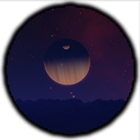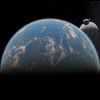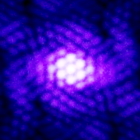|
Geology on planets.
|
|
| arturuniverse | Date: Sunday, 04.09.2016, 19:40 | Message # 1 |
 Astronaut
Group: Users
 Pirate
Pirate
Messages: 60
Status: Offline
| Earth.
Earth is an amazing planet, with one of the biggest terrain and biomes variations of all ever discovered celestial bodies on the universe, having its mountains, deserts, valleys, rivers, forests, beaches, islands, hills, depressions, plains, volcanoes, seas, and thousands of other incredible variations that are mind blowing. Rarely a planet has so much diversity and Life (not the biological type). But, unfortunately, Space Engine, as a space simulator, don’t render such an amazing variation in other planets. And here are some things I want to say about it.
Let’s summarize things here: Space Engine planets are not accurate (In geology), look, for example this image: http://i.picpar.com/4cdbf0332afabfc195d359562e324bc94cd9f9b5.jpg
Now, when looking at this, l ooks amazing right? So many different types of colors and landscapes to see! Like a party, but, when approached, the planet, instead of having monoliths, arcs, depressions, valleys, and small variations like random parts of the terrain deformed because of geology and erosion, you have, this:
https://i.ytimg.com/vi/RSreH-Zg4P8/maxresdefault.jpg
Or, in deserts:
http://i.dailymail.co.uk/i....PNG.jpg
Or this:
https://encrypted-tbn0.gstatic.com/images?....UummI4u
https://encrypted-tbn2.gstatic.com/images?....-i4TpCj
And things like, that. But now, for example, here is Mars, with its features (real life):
https://encrypted-tbn3.gstatic.com/images?....C_tew8u
http://marsoweb.nas.nasa.gov/globalData/images/fullscale/geology.jpg
THAT’S CRAZY BOI.
But, even so, Mars is pretty cheap compared to IO geological map:
http://www.scottbuckley.com.au/musosci....ped.jpg
Alright, you know Mercury? That boring and empty desert that anyone likes? DAMN SON:
http://astropedia.astrogeology.usgs.gov/downloa....max.jpg
And even Pluto has a lot of variety. Earth? Just look at /r/Earthporn and you will see a lot of different biomes and landscapes formations all across the globe.
And with all of that, it’s just disappointing sometimes, seeing a planet, such a giant feature in the game, and a big part of the universe, be so monotone, with a plain, some little rivers, and after that, a spiky mountain. Don’t even get me started at single-biome planets.
All I know is that SE uses perlin noise with variables and features to creature planet textures, and then, it render in a 3D landscape via C++ compiler, and I imagine how hard is to render that. It’s just crazy, but, someone in this community could do a little help on that? I contacted the school that I am in the moment, and they started use SE, even them liking it so much, and love the planets and accuracy, sometimes the geography is not complete and have a lack of stuff. So, what’s the plan here? Well, just make better what Space Engine already does: Take the characteristics of the planet, and have variations with lat. and long. So the game can render the diversity depending on the planet specs, following rules and simple charts that can be designed. So, for example, it’s an -2C° plain composite of principally rock (silicon, iron, traces of compacted carbon, some magnesium covering the ground), and some ice water on packed depressions, right after a big mountain chain. Since it’s:
- Lower than 5 C° average temperature, is considered cold |Cold.
- It’s a big plain with little variations. | Plain.
- Principally composed of single continuous material, deposited by some kind of erosion, or just because geological formation occurred. | Straight materials.
- No kind of life whatsoever. | Empty of fauna or flora.
These attributes are recognized as a desert, right? So just add more patterns and little variations. I know it’s currently represented erosion or landscape evolution through any known GPU means, but, just try it. Also, maps from Brazil, one country and small part of a single planet:
ftp://geoftp.ibge.gov.br/informa....mas.pdf
ftp://geoftp.ibge.gov.br/informacoes_ambientais/geomorfologia/mapas/brasil/relevo_2006.pdf
And the site to himawari-8 live:
http://himawari8.nict.go.jp/
P.S: I know about the 'geology' thread on science and astronomy.
We all have an end, but we choose and create that end by ourselves.
|
| |
| |
| sclarinval | Date: Sunday, 04.09.2016, 23:04 | Message # 2 |
 Astronaut
Group: Users
 Pirate
Pirate
Messages: 41
Status: Offline
| Some nice ideas and very well written, it's cool that you have an actual solution as well! Though I'm not sure that this should necessarily be a priority, as the surfaces already look fairly good (If not extremely realistic). In terms of landscapes, I think the priority should be to increase the level of detail when close up, and make water look better. But still, it'd be great if this could be added to the to-do list.
|
| |
| |
| Hornblower | Date: Sunday, 04.09.2016, 23:31 | Message # 3 |
 World Builder
Group: Users
 United States
United States
Messages: 714
Status: Offline
| I also posted about this a while ago here
Edited by Hornblower - Sunday, 04.09.2016, 23:31 |
| |
| |
| Planetcracker | Date: Wednesday, 07.09.2016, 13:45 | Message # 4 |
|
Observer
Group: Newbies
 Greenland
Greenland
Messages: 1
Status: Offline
| I think the most efficient way would be some kind of hybrid solution:
First,if there's an ocean there could be a very simple process
to optimise continent formation.On earth nearly all continents have been created
by "Seeds" called Cratons wich formed through
volcanic activity somewhere between 3-4 billion years ago.
The rest of the continental crust has been
attached over the course of the last few billion years.
An example of the early continental configuration and the smaller Area it occupies.

To optimise the creation, random seeds in conjunction with the known age of the planet could be used to draw the outline
of the continental crust and the appropriate size of it.
Second there should be a system wich may work randomly or in respect
of the continental configuration
wich determines how "rough" or "smooth" the coastline should be.
Africa as an example is very smooth due toits prior position in the heart of Pangea,
while Europe has a lot of small islands and Island seas.
Third would be the normal process of "filling" the inland with the old system of functions.
Maybe there could be a system
which draws lines where mountain ranges should be created,
so it doesn't look like a bunch of simple bumps in the landscape.
Fourth is the polishing: Rivers wich flow from the highest to the lowest points
and erosion with all the colors and formations, in
respect of the climate model, wich are associated with it.
I also think this could be applied for other planet types.
|
| |
| |
| SpaceEngineer | Date: Wednesday, 07.09.2016, 14:19 | Message # 5 |
 Author of Space Engine
Group: Administrators
 Russian Federation
Russian Federation
Messages: 4800
Status: Offline
| All this may look obvious when you talking about that. But then you decided to start coding, you'll ended up with question "how"? Taking into account the way SE and other procedural engines handing planets, it will be obvious, what these "simple" things are almost impossible to implement:
Quote Planetcracker (  ) Maybe there could be a system which draws lines where mountain ranges should be created, so it doesn't look like a bunch of simple bumps in the landscape.
Quote Planetcracker (  ) Rivers wich flow from the highest to the lowest points
Quote Planetcracker (  ) erosion with all the colors and formations, in respect of the climate model, wich are associated with it.
This is because how procedural terrain works. It doesn't know anything about global geology map like biomes, humidity etc. It cannot "draw the line". Because procedural function knows only one parameter: point position on the globe (you may think about it as latitude + longitude). It must generate surface point (ie elevation and color) using only this data, together with some global planet parameters (planet type, average temperature, palette table etc).
Some limited iterative process is possible to simulate low-scale erosion, but global one is impossible. Continent formation and drift is only possible as a low-resolution basic map, but it is not implemented in SE yet. Computing biomes based on physics (moving air masses, changing humidity etc.) probably is possible on a very low resolution scale, or maybe impossible at all (hey, it is a climate modelling, scientists using supercomputers for that!). Drawing "lines" to use them as base for rivers and mountain rages is impossible due to nature of the algorithm.
Now you see, procedural generation is a complex thing, and making it close to reality is very challenging task.

|
| |
| |
| arturuniverse | Date: Wednesday, 07.09.2016, 16:58 | Message # 6 |
 Astronaut
Group: Users
 Pirate
Pirate
Messages: 60
Status: Offline
| Quote Planetcracker (  ) Fourth is the polishing: Rivers wich flow from the highest to the lowest points
and erosion with all the colors and formations, in
respect of the climate model, wich are associated with it.
No, that's impossible in SE current level. As Vlad said, procedural generation is a bunch of open variables on the code, that randomly generate according to the planet seed. Increasing more variables is the point of the software, because, originally, the game doesn't know what a "planet" is, it just generates bodies with that parameters.
Creating erosion isn't procedural, is an complex simulation, that changes a lot of factors along time. For exemple: River erosion. You need to do the pressure, velocity, force of the flow, it's direction, the material eroding around it, bigger and smaller particles interacting in the general structure of the terrain. It's just a massive thing. When GPUs get strong enough, I think it would be a nice thing to have but, SE doesn't even have the simulation of n-body problems, wich are one of the biggest problems in every space
simulation game. Yeah.
Quote Planetcracker (  ) Third would be the normal process of "filling" the inland with the old system of functions.
Maybe there could be a system
which draws lines where mountain ranges should be created,
so it doesn't look like a bunch of simple bumps in the landscape.
Yeah, it would be neat, but, how? The game can't recognize what is a mountain or an valley, "valley" to him, is some open variables following these rules. Where mountains should be created? Tectonic movement is a great answer, but not appliable.
We all have an end, but we choose and create that end by ourselves.
|
| |
| |
| Hornblower | Date: Wednesday, 07.09.2016, 19:54 | Message # 7 |
 World Builder
Group: Users
 United States
United States
Messages: 714
Status: Offline
| For me, geology would make the game less repetitive.
______________________________________________________________________________
So how do you fix this?
First of all, to create more variety, the parameters of features on a planet should be wildly different.
This is what I got after making some of the values in the editor a bit more random:
Second, you should create many more variables like cellular plains, rough plains, salt plates, etc. but don't force all these variables to be present on every planet of a specific type. For example, maybe only 20% of selenic worlds in the game express cellular plains. Also, the values of variables should also depend on other variables. For example, if a planet is volcaniclly active, there should be less craters (the older ones would be covered with new material). Randomly select what features will be on a planet, then based that generation, set all the sliders that aren't expressed down to 0 frequency. Then, most importantly, the characteristic that are selected for the planet should have a wider variety of parameters. This will ultimately lead to more unique geological variety in planets.
Lastly, there should be more variety in the colors of the planets. Like with Io, there should be a chance to generate a yellow selena, or a dark green selena, or some other color we see in selenic worlds in our Solar System.
Edited by Hornblower - Wednesday, 07.09.2016, 20:01 |
| |
| |
| SpaceEngineer | Date: Wednesday, 07.09.2016, 21:09 | Message # 8 |
 Author of Space Engine
Group: Administrators
 Russian Federation
Russian Federation
Messages: 4800
Status: Offline
| Quote Hornblower (  ) For me, geology would make the game less repetitive.
So how do you fix this?
First of all, to create more variety, the parameters of features on a planet should be wildly different.
This is what I got after making some of the values in the editor a bit more random:
You can find this variety in SE without any tweaking, by better searching.
Quote Hornblower (  ) Second, you should create many more variables like cellular plains, rough plains, salt plates, etc.
Each new terrain type adds a conditional branch to the terraing generation shader. It is already the most large shader in SE. Texture 256*256 takes 3-5 ms to generate. So each new landform will increase this time, and overall planet generation time. There must be a good compromise with speed and terrain variety (also variety can be achieved by tweaking parameters of the existing landform functions). At some point you will have so large and complex generation shader, so performing iterative geological simulation would be faster.
Quote Hornblower (  ) but don't force all these variables to be present on every planet of a specific type. For example, maybe only 20% of selenic worlds in the game express cellular plains. Also, the values of variables should also depend on other variables. For example, if a planet is volcaniclly active, there should be less craters (the older ones would be covered with new material).
This is exactly how SE works right now.
Quote Hornblower (  ) Like with Io, there should be a chance to generate a yellow selena
They are exist in SE, search more carefully.

|
| |
| |
| Hornblower | Date: Wednesday, 07.09.2016, 22:16 | Message # 9 |
 World Builder
Group: Users
 United States
United States
Messages: 714
Status: Offline
| Quote SpaceEngineer (  ) search more carefully
Maybe it's a problem with my computer. Every selena I find looks like this:

Also, what is the light-brown thing supposed to be on all the selenas?
Edited by Hornblower - Wednesday, 07.09.2016, 22:17 |
| |
| |
| Ingolifs | Date: Thursday, 08.09.2016, 00:12 | Message # 10 |
|
Space Tourist
Group: Users
 New Zealand
New Zealand
Messages: 30
Status: Offline
| Quote Also, what is the light-brown thing supposed to be on all the selenas?
It may have something to do with this:
http://en.spaceengine.org/forum/21-11-16
|
| |
| |
| Hornblower | Date: Thursday, 08.09.2016, 00:24 | Message # 11 |
 World Builder
Group: Users
 United States
United States
Messages: 714
Status: Offline
| Ingolifs, That is not the brown blob that is on every selena.
_____________________________
Ok, so I see my error. The giant brown area on the selenas draws too much attention away from the randomness of the planet. What is the brown area and is there a way to remove it?
Edited by Hornblower - Thursday, 08.09.2016, 00:30 |
| |
| |
| arturuniverse | Date: Thursday, 08.09.2016, 00:53 | Message # 12 |
 Astronaut
Group: Users
 Pirate
Pirate
Messages: 60
Status: Offline
| Quote SpaceEngineer (  ) Each new terrain type adds a conditional branch to the terraing generation shader. It is already the most large shader in SE. Texture 256*256 takes 3-5 ms to generate. So each new landform will increase this time, and overall planet generation time. There must be a good compromise with speed and terrain variety (also variety can be achieved by tweaking parameters of the existing landform functions). At some point you will have so large and complex generation shader, so performing iterative geological simulation would be faster.
So that's a thing.
Well, some years ago, at the Science Department of Minas Gerais, Brazil, some gals did and synthesis of rendering an massive 3D procedural environment (like a planet) whitout much of a lag and aliasing: http://homepages.dcc.ufmg.br/~chaimo/public/SIBIGRAPI10.pdf
And this:
http://dl.acm.org/citation.cfm?id=2856409
By what I've understand, the bigger the parameters and open variables, the seed is bigger, and harder to render with much of a detail whitout the coordinate problem? I guess, If those variables were added, planets in the edge of the universe wouldn't have that much of a detail?
We all have an end, but we choose and create that end by ourselves.
|
| |
| |
| cristobal_leal | Date: Friday, 11.11.2016, 17:56 | Message # 13 |
 Observer
Group: Users
 Pirate
Pirate
Messages: 14
Status: Offline
| Quote Hornblower (  ) First of all, to create more variety, the parameters of features on a planet should be wildly different.
This is what I got after making some of the values in the editor a bit more random:
Yes! YES!! Pls, Vladimir, read this thread.
|
| |
| |
| Watsisname | Date: Saturday, 12.11.2016, 00:05 | Message # 14 |
 Galaxy Architect
Group: Global Moderators
 United States
United States
Messages: 2613
Status: Offline
| He has been reading and posting in this thread throughout...

|
| |
| |
| cristobal_leal | Date: Saturday, 12.11.2016, 10:26 | Message # 15 |
 Observer
Group: Users
 Pirate
Pirate
Messages: 14
Status: Offline
| Oh!
Anyway, I think maybe the solution is sacrifice some of realism and add a bit of fantasía. Is not necessary do a generator ultra-realistic of procedural planets. Enough with do a generator pretty and variety. Thus there will always be new things to explore.
Quote SpaceEngineer (  ) They are exist in SE, search more carefully.
Pls, Vlad...
Surely there are many types of planets out there. But that's not the point, necessarily. We want more variety AND MORE OFTEN.
Edited by cristobal_leal - Saturday, 12.11.2016, 10:28 |
| |
| |